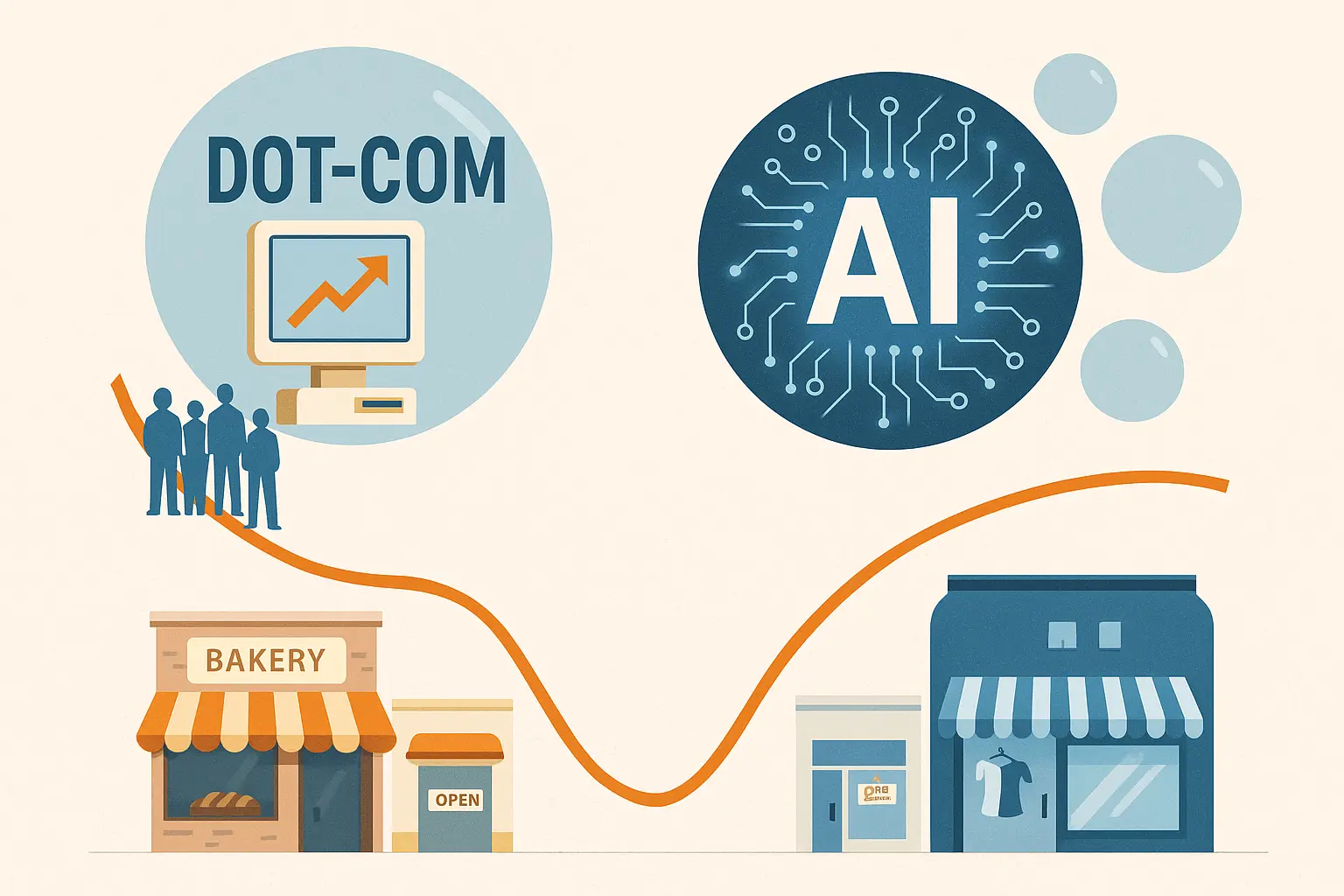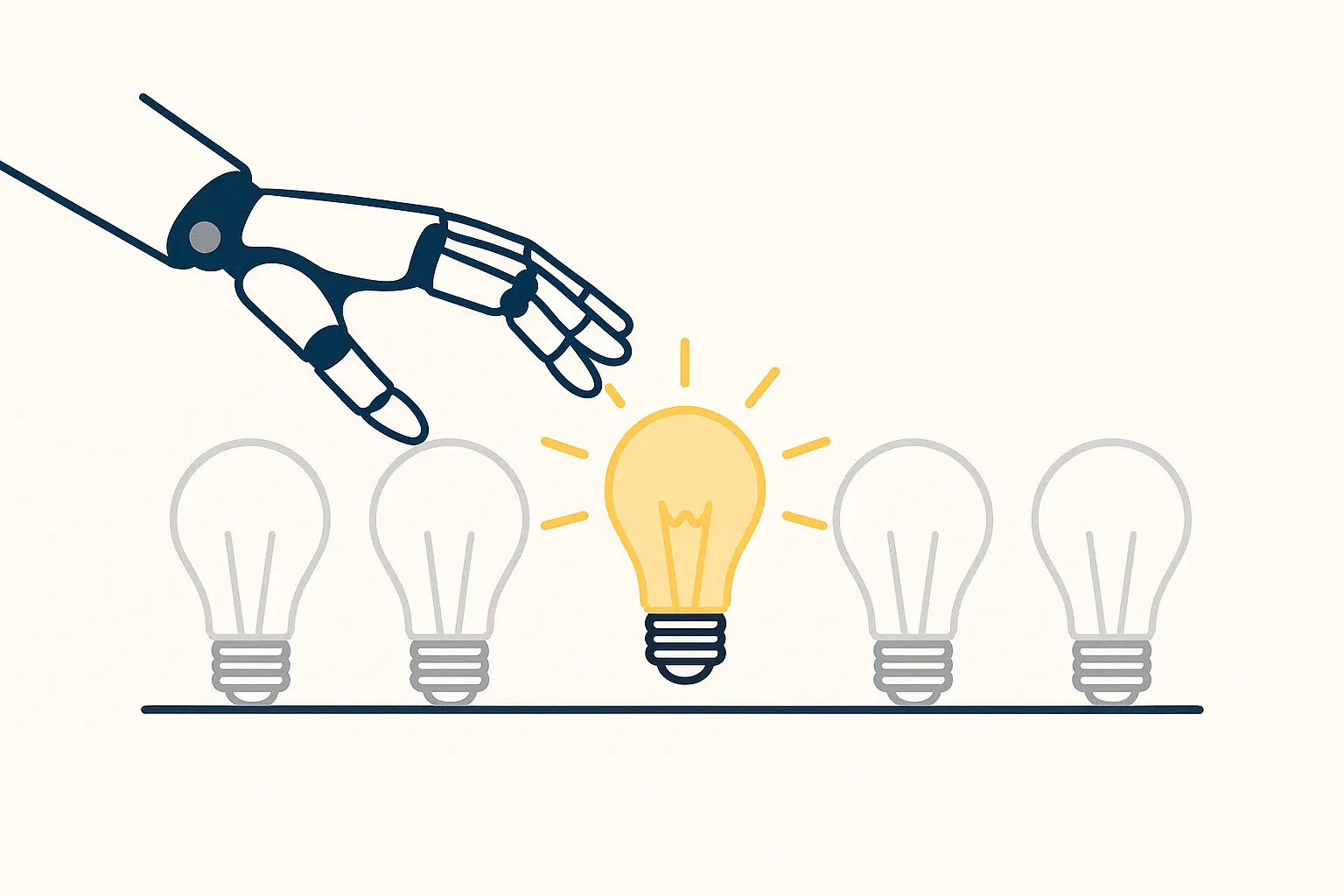 AI is everywhere right now — jammed into apps, tacked onto product roadmaps, and splashed across headlines promising effortless growth. It feels exciting. It also feels familiar. If you remember the late-’90s dot-com boom, you’ve seen this movie: money pours in, everyone rushes to “get online,” and a lot of businesses bet their future on tools and platforms they don’t fully understand. When the bubble popped, it wasn’t just the .com startups that suffered — vendors, agencies, and perfectly good businesses that depended on them took a hit, too.
AI is everywhere right now — jammed into apps, tacked onto product roadmaps, and splashed across headlines promising effortless growth. It feels exciting. It also feels familiar. If you remember the late-’90s dot-com boom, you’ve seen this movie: money pours in, everyone rushes to “get online,” and a lot of businesses bet their future on tools and platforms they don’t fully understand. When the bubble popped, it wasn’t just the .com startups that suffered — vendors, agencies, and perfectly good businesses that depended on them took a hit, too.
Today’s AI surge isn’t a copy-paste of the dot-com era, but the business risks rhyme. The danger isn’t that AI “won’t work.” The danger is overdependence — tying visibility, operations, or profitability to a single tool or platform and calling it strategy. If your entire pipeline hinges on one trendy app (or one social network, or one AI model), you’re not innovating — you’re gambling.
This article cuts through the hype. We’ll compare the AI wave to the dot-com bubble, show what that means for small businesses right now, and outline a practical way to adopt AI as leverage — not a lifeline — so you stay resilient no matter how the market shakes out.
The Parallels Between the Dot-Com
and AI Bubbles
 In the late 1990s, “getting online” was the buzzword. Venture capitalists poured billions into internet startups — many of which had no clear business model, revenue, or path to profit. The logic was simple: the internet was the future, so anything tied to it had to be valuable. That logic worked — until it didn’t. When the dot-com bubble burst in 2000, trillions of dollars in market value disappeared almost overnight.
In the late 1990s, “getting online” was the buzzword. Venture capitalists poured billions into internet startups — many of which had no clear business model, revenue, or path to profit. The logic was simple: the internet was the future, so anything tied to it had to be valuable. That logic worked — until it didn’t. When the dot-com bubble burst in 2000, trillions of dollars in market value disappeared almost overnight.
AI is following a similar curve. Companies are slapping “AI-powered” onto every product, from toothbrushes to to-do list apps, and investors are again chasing the gold rush. The difference today is speed: what took a decade to inflate during the dot-com era is unfolding in a matter of months.
Just like then, two things are happening simultaneously:
- Overvaluation of AI-focused companies – Money is flooding into startups that are exciting, but untested. Many depend entirely on access to a single AI model or API that could change, disappear, or become unaffordable overnight. When costs rise or results disappoint, those companies will collapse — just like many dot-coms did when ad revenue dried up or servers got too expensive.
- Overreliance by existing businesses – Thousands of small businesses are now building their workflows, marketing, and even customer relationships around AI tools they don’t own or control. In the dot-com era, this was the web hosting or e-commerce platform that suddenly went under. Today, it’s the AI assistant or automation system you’ve built your client process around. When one domino falls, it hits a lot of unsuspecting businesses downstream.
Both bubbles share the same underlying issue: belief that technology itself guarantees success. It never does. Tools amplify strategy—they don’t replace it.
How the AI Bubble Impacts Small Businesses Right Now
 For most small business owners, the AI boom feels less like Wall Street noise and more like a constant wave of “must-have” tools. Every week, there’s a new app that claims to write your marketing, handle customer service, or run your entire business automatically. The pressure to “adopt AI before you’re left behind” is real — but so is the risk of overcommitting.
For most small business owners, the AI boom feels less like Wall Street noise and more like a constant wave of “must-have” tools. Every week, there’s a new app that claims to write your marketing, handle customer service, or run your entire business automatically. The pressure to “adopt AI before you’re left behind” is real — but so is the risk of overcommitting.
Here’s where the bubble becomes personal:
1. Rising Dependence on Fragile Systems
Many small businesses are now building key parts of their operations on top of AI tools they don’t own — tools that depend on someone else’s servers, algorithms, and pricing. If that provider changes their API, goes under, or starts charging five times as much (like some already have), your entire workflow could grind to a halt overnight. It’s the same vulnerability early e-commerce stores faced when their hosting company folded in 2001.
2. Inflated Expectations
During the dot-com era, businesses rushed online believing that “being on the internet” was a strategy. Today, “using AI” carries the same illusion. But installing an AI chatbot doesn’t make your business more profitable any more than owning a website did in 1999. Without a clear purpose — like improving efficiency, enhancing customer experience, or reducing costs — it’s just noise.
3. Shifting Marketing Landscapes
Platforms are changing faster than ever. Social algorithms now favor AI-generated content — until they suddenly don’t. If your marketing depends on what the algorithm likes this month, you’re not building a brand, you’re chasing a trend. It’s the digital equivalent of renting space in someone else’s mall — convenient while it lasts, but gone when the lease changes.
4. The False Security of Automation
Automation feels safe — it’s efficient, measurable, and scalable. But when you over-automate, you lose touch with the human side of your business. Clients notice. Employees disengage. Your brand voice becomes generic. The businesses that thrive through every technological shift are the ones that use tools to enhance their strengths, not replace them.
Building Resilience in the Age of AI
 Technology cycles always start with excitement, followed by overreach, and finally, a reckoning. The businesses that endure aren’t the ones that chase every wave — they’re the ones that build solid ground between them. AI can absolutely give small businesses an advantage, but only when used as a strategic layer, not the foundation.
Technology cycles always start with excitement, followed by overreach, and finally, a reckoning. The businesses that endure aren’t the ones that chase every wave — they’re the ones that build solid ground between them. AI can absolutely give small businesses an advantage, but only when used as a strategic layer, not the foundation.
Here’s how to stay adaptable, profitable, and sane through whatever comes next:
1. Use AI to Strengthen, Not Substitute
Ask yourself one simple question before adopting any tool: Does this make my core business stronger, or just easier?
AI should amplify your best systems — streamlining repetitive work, analyzing data faster, or enhancing creativity — not replace the fundamentals like customer relationships, human judgment, or brand trust.
2. Keep Ownership of Your Systems
If you depend on AI for your website copy, customer service, or workflow management, make sure you can take those processes with you. Own your data. Export your content. Keep backup systems. When an AI tool shuts down or shifts pricing, you want to pivot — not panic.
3. Diversify Your Digital Footprint
Never tie your business survival to a single platform. Facebook might throttle your reach. A new regulation might change what TikTok can do. AI tools can go offline without warning. The solution? Spread your risk: build your email list, nurture real relationships, and ensure that your business can communicate and operate across multiple channels.
4. Stay Human-Centered
AI can mimic tone, generate ideas, and predict behavior — but it can’t build trust, empathy, or reputation. As automation expands, authentic connection becomes your biggest differentiator. Use AI to enhance the human experience your brand offers, not to replace it.
5. Prepare for the Pop
When the AI bubble inevitably cools, the market will consolidate. Some tools will disappear; others will stabilize. Businesses that treated AI as a tactical advantage — not a total dependency — will stand strong. The rest will scramble to rebuild their systems. Decide now which group you want to be in.
The Illusion of Safety in the AI Era
 Every technological boom carries a promise: This one is different. Investors said it about railroads, dot-coms, crypto, and now, AI. The illusion is always the same — believing that widespread adoption equals permanence. But if history teaches anything, it’s that no tool or platform is too big to fail, and no innovation is immune to market correction.
Every technological boom carries a promise: This one is different. Investors said it about railroads, dot-coms, crypto, and now, AI. The illusion is always the same — believing that widespread adoption equals permanence. But if history teaches anything, it’s that no tool or platform is too big to fail, and no innovation is immune to market correction.
Small business owners are especially vulnerable to this mindset because AI tools feel like an equalizer. With a few clicks, you can produce ad campaigns, analyze sales data, or automate entire workflows. It’s empowering — but also deceptive.
1. Dependency Disguised as Efficiency
When your systems run on AI platforms, you stop noticing how much you depend on them. It’s convenient until the day the system goes down, changes pricing, or decides you’ve hit your “free tier limit.” Just like businesses that vanished when Yahoo Stores, GeoCities, or early e-commerce platforms went dark, AI-reliant businesses will find themselves scrambling to rebuild when their critical tools disappear.
2. The Myth of Indispensability
It’s easy to assume that giants like OpenAI, Anthropic, or Google will always be there — but markets move fast. Regulations shift, investors pull out, competitors catch up, and technology evolves. If your business is only stable because of one external platform, you’re effectively leasing your future.
3. The Confidence Trap
Automation success breeds complacency. Once your AI systems seem to “just work,” it’s tempting to stop checking the data or skip testing new processes. That false confidence is what turned the dot-com rush into a crash: everyone assumed growth would last forever — until it didn’t.
The safest small businesses in the AI era will be the ones that stay grounded in reality: treating technology as a partner, not a promise.
The Smart Path Forward
 AI is not the enemy of small business — it’s an accelerant. The challenge is knowing when to hit the gas and when to steer. Like the early internet, AI will evolve from wild speculation to practical integration, and the winners will be those who built with patience and perspective.
AI is not the enemy of small business — it’s an accelerant. The challenge is knowing when to hit the gas and when to steer. Like the early internet, AI will evolve from wild speculation to practical integration, and the winners will be those who built with patience and perspective.
Here’s what that looks like in action:
1. Adopt Slowly, Integrate Deeply
Don’t rush to implement every new AI tool that trends on social media. Instead, test selectively. Find one use case — like automating client follow-ups or generating better reports — and refine it until it genuinely improves your results. Then move on to the next. Sustainable adoption beats scattered enthusiasm every time.
2. Think Long-Term Systems, Not Short-Term Gains
If an AI tool disappeared tomorrow, could your business still function? That’s the test. Build processes that survive without any single platform. Treat AI as an assistant, not the architect.
3. Invest in Human Skill, Not Just Machine Skill
The businesses that thrive after the bubble will be led by owners who know how to think, not just prompt. Critical thinking, creativity, and empathy can’t be automated — and they’re exactly what clients will crave as automation becomes ordinary.
4. Keep Perspective When the Bubble Pops
When hype fades, opportunity grows. Just as Amazon, Google, and eBay emerged from the ashes of the dot-com crash, the AI correction will clear the noise and leave space for those who built wisely. If you’ve used AI to enhance — not replace — your business model, you’ll come out stronger, leaner, and ahead of the curve.
5. Stay Curious — but Stay Grounded
Experiment. Learn. Adapt. But remember: the most powerful technology in your business will always be the human mind guiding it.
Adapt, Don’t Abdicate
 Every technological revolution feels unstoppable until it isn’t. The AI boom will create incredible opportunities — but only for business owners who stay grounded in the fundamentals of strategy, systems, and human value. Don’t hand your future to a tool or a trend. Build a business that can use AI without being used by it.
Every technological revolution feels unstoppable until it isn’t. The AI boom will create incredible opportunities — but only for business owners who stay grounded in the fundamentals of strategy, systems, and human value. Don’t hand your future to a tool or a trend. Build a business that can use AI without being used by it.
If you’re not sure how to future-proof your strategy or want to identify where AI fits best in your operations, let’s talk. Strategic Horizons Consulting helps business owners think beyond the hype and build businesses that last — startup to exit and everything in between.
Schedule a consultation today and learn how to build a business that thrives in any market cycle.